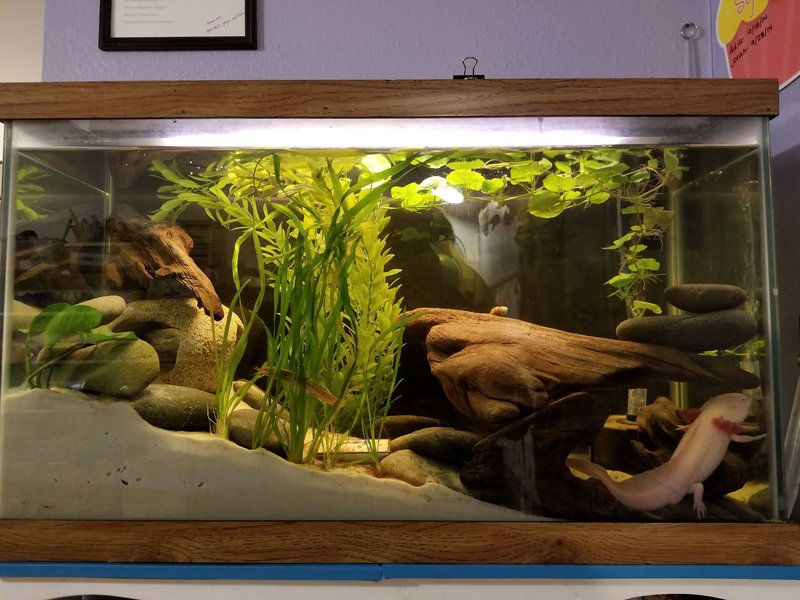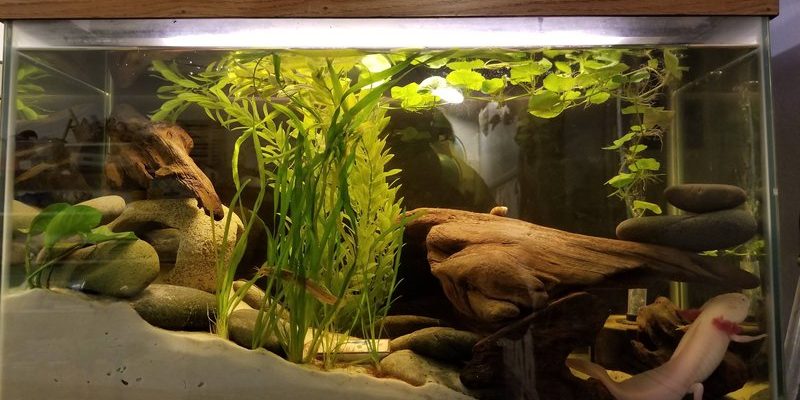
When it comes to tank setup, the key is understanding what makes axolotls tick. They’re not just any fish; they’re aquatic amphibians that live in freshwater. So, you’ll need to keep this in mind while setting up their home, from choosing the right tank size to making sure the filtration system works without causing harm. You might be wondering where to start or how to create a space that keeps your axolotl happy and healthy. Don’t worry; I’ll walk you through everything step by step.
Choosing the Right Tank Size
The first thing you need to consider is tank size. Axolotls can grow to be quite large—up to 12 inches in some cases—so they need plenty of room to move around. A good rule of thumb is to have at least 10 gallons of water for every axolotl. If you plan on having more than one, remember to add extra space. A 20-gallon tank is usually a good starting point for one or two axolotls.
Here’s the thing: larger tanks are not only better for your axolotls’ health, but they also help maintain water quality. Smaller tanks can heat up quickly and may have fluctuations that stress out your little buddy. Think of it like living in a cramped apartment versus a spacious home. Which would you prefer? More room gives them the freedom to express their natural behavior, each creature having its own territory, which can reduce stress.
Also, consider the tank’s height. Axolotls are bottom dwellers, so a taller tank isn’t necessary. It’s better to have a longer tank as it provides more surface area, which is important for gas exchange. Look for a tank that is at least 30 gallons if you are going for a community setup.
Understanding Filtration Options
Now that you have the tank size sorted, let’s talk about filtration. Axolotls produce a lot of waste, so a quality filter is essential for keeping the water clean and healthy. A canister filter is often recommended because it provides strong filtration without creating too much water flow.
You might be wondering why water flow matters. Axolotls don’t like strong currents, as they prefer a calm environment. If your filter is too powerful, it can create a mini whirlpool that might stress them out. To combat this, you can adjust the filter or add filter media that helps diffuse the water flow.
When setting up the filter, make sure it’s positioned to prevent direct current on your axolotl. One way to do this is by angling it away from where your axolotl tends to hang out. This way, they can enjoy clean water without battling against the current.
Water Temperature and Conditions
Temperature is another crucial factor in your axolotl’s tank setup. These critters thrive in cooler water, typically between 60°F and 68°F (15°C to 20°C). Going above this range can lead to stress and health issues. You might think, “But it’s just a little warmer.” Trust me, even a small temperature change can have a big impact on their wellbeing.
To maintain the right temperature, you may need to invest in a reliable aquarium heater. But here’s the catch: not all heaters are created equal. A submersible heater with a thermostat is a great choice. Avoid using those floating heaters that can heat the water unevenly.
Regularly testing the water temperature with a thermometer will help you keep an eye on things. This little piece of equipment is essential for any successful axolotl setup. Plus, it’s good practice to check your water test levels regularly.
Creating the Ideal Substrate
Next up is the tank substrate. While you may be tempted to use gravel, it’s generally not recommended for axolotls. They often swallow small pebbles, which can lead to serious health issues. Instead, consider using sand or bare bottom for their tank.
Sand provides a natural look and is much safer. It’s easy to clean and doesn’t pose a choking hazard. If you choose to go with sand, make sure it’s fine gravel or aquarium-safe. Here’s a tip: rinse the sand thoroughly before adding it to the tank to remove any dust or debris.
A bare-bottom tank makes cleaning a breeze. It allows you to easily spot uneaten food or waste, which can be hard to see in a sandy environment. It’s all about finding the balance between aesthetics and practicality.
Plants and Decorations for Comfort
Your axolotl will appreciate some decorations and plants in their environment. Live plants can help improve water quality and provide hiding spots, which makes your axie feel secure. However, avoid sharp-edged plants as they can injure your pet.
You can choose from low-maintenance options like Java Fern, Anubias, or Moss. These plants tend to do well in cooler water and don’t require fancy lighting. If you prefer decorations, opt for smooth, non-toxic items like driftwood or caves. These provide excellent hiding spaces and add to the aesthetic of the tank.
Just don’t overcrowd the tank! Too many decorations can limit swimming space, which is crucial for your axolotl’s happiness. Remember, it’s about their comfort, too.
Maintaining Water Quality
Lastly, let’s chat about maintaining water quality. Regular water changes are a must. Aim to change about 20-30% of the water weekly. It helps to keep the ammonia and nitrite levels in check, which is vital for your axolotl’s health.
You might want to invest in a water testing kit to keep an eye on parameters like pH, ammonia, and nitrites. Keeping the pH level around 6.5 to 7.5 is ideal for axolotls. This routine ensures your axolotl lives in a safe and clean environment, reducing stress and promoting a longer life.
While it sounds like a lot of work, getting into a routine will make it easier. Plus, you’ll build a strong bond with your pet, knowing you’re providing the best possible environment for them.
Setting up the perfect tank for your axolotl involves careful thought and planning. From selecting the right size tank to ensuring the water temperature is just right and maintaining water quality, each step is crucial in providing a happy home. Remember, axolotls are unique creatures that thrive in specific conditions, so putting in the effort will pay off in their happiness and health.
Honesty is key here; the more effort you put in now, the more you’ll enjoy watching your axolotl thrive. So get started on your tank setup, and revel in the joy of caring for these remarkable pets!

